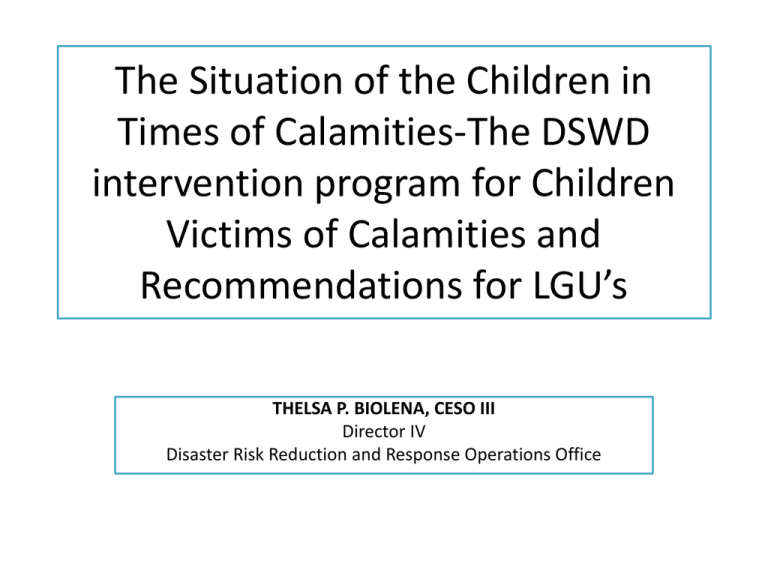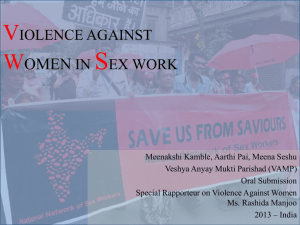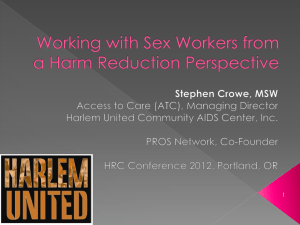
The Situation of the Children in
Times of Calamities-The DSWD
intervention program for Children
Victims of Calamities and
Recommendations for LGU’s
THELSA P. BIOLENA, CESO III
Director IV
Disaster Risk Reduction and Response Operations Office
Definition of Child/ren and Age Groups
• A “minor” who is anyone under 18 years old
Age Groups:
0-1 newborn
1-3 toddler
3-6 pre-schooler
6-12 schooler
12-18 adolescents
Rights of Children
1.
2.
3.
4.
5.
6.
Every child is endowed with dignity and worth of human being from the moment
of his conception, as generally accepted in medical parlance, and has therefore,
the right to be born well.
Every child has the right to a wholesome family life that will provide him with
love, care and understanding, guidance and counselling, moral and material
security.
Every child has the right to a well-rounded development of his personality to the
end that he may become a happy, useful, and active member of society.
Every child has the right to a balanced diet, adequate clothing, sufficient shelter,
proper medical attention, and all the basic physical requirements of a healthy
and vigorous life.
Every child has the right to be brought up in an atmosphere of morality and
rectitude for the enrichment and the strengthening of his character.
Every child has the right to an education commensurate with his abilities and to
the development of his skills for the improvement of his capacity for service to
himself and his fellowmen.
Rights of Children
7.
Every child has the right to full opportunities for safe and wholesome recreation
and activities, individual as well as social, for the wholesome use of his leisure
hours.
8. Every child has the right to protection against exploitation, improper influences,
hazards, and other conditions or circumstances prejudicial to his physical,
mental, emotional, social, and moral development.
9.
Every child has the right to live in a community and a society that can offer him
an environment free from pernicious influences and conducive to the promotion
of his health and the cultivation of his desirable traits and attributes.
10. Every child has the right to the care, assistance, and protection of the state,
particularly when his parents or guardians fail or are unable to provide him with
his fundamental needs for growth, development, and improvement.
11. Every child has the right to an efficient and honest government that will deepen
his faith in democracy and inspire him with the morality of the constituted
authorities both in their public and private lives.
12. Every child has the right to grow up as a free individual, in an atmosphere of
peace, understanding, tolerance, and universal brotherhood and with the
determination to contribute his share in the building of a better world.
Child Protection Issues
• Birth Registration
• The official recording of a child’s birth by the government.
Establishes the existence of the child under law and provides the
foundation for safeguarding many of the child’s civil, political,
economic, social and cultural rights.
• Child Labour
• Millions of children around the world are trapped in child labour,
depriving them of their childhood, their health and education, and
condemning them to a life of poverty and want. Of course, there is
work that children do to help their families in ways that are neither
harmful nor exploitative. But many children are stuck in
unacceptable work for children – a serious violation of their rights.
Child Protection Issues
• Child Marriage
• Child marriage, defined as a formal marriage or informal union
before age 18, is a reality for both boys and girls, although girls are
disproportionately the most affected. Child marriage is widespread
and can lead to a lifetime of disadvantage and deprivation.
• Child Recruitment by Armed Forces or Armed Groups
• Around the world, thousands of boys and girls are recruited into
government armed forces and rebel groups to serve as combatants,
cooks, porters, messengers or in other roles. Girls are also recruited
for sexual purposes or forced marriage. Many have been recruited
by force, though some may have joined as a result of economic,
social or security pressures. Situations of displacement and poverty
make children even more vulnerable to recruitment.
Child Protection Issues
•
•
•
•
•
A 1997 report put the number of child victims of prostitution at 75,000 in the
Philippines.,[10] with other estimates saying as many as 100,000.[11]
According to the United Nations Children's Fund (Unicef) estimated 60,000 to
100,000 children in the Philippines were involved in prostitution rings.[12]
According to the International Labour Organization (ILO) about 100,000
children were involved in prostitution as of 2009.[13] is a high incidence of child
prostitution in tourist areas. An undetermined number of children are forced
into exploitative labor operations.[12]
It was estimated in 1995 that the Philippines was the fourth country with the
most number of prostituted children,[14] and authorities have identified an
increase in child molesters travelling to the Philippines.[15]
In 2007, there were estimated to be 375,000 women and girls in the sex trade
in the Philippines, mostly between the ages of 15 and 20, though some are as
young as 11.[16]
The International Federation of Red Cross and Red Crescent Societies stated in
2003 that there were more than 1.5 million street children in the Philippines
and many end up in prostitution and drug trafficking in places such as Manila
and Angeles City.[17]
Child Protection Issues
• Government and NGO estimates in 2007 on the number of women
trafficked ranged from 300,000 to 400,000 and the number of children
trafficked ranged from 60,000 to 100,000.[18] According to the US
government reports, the number of child victims in the Philippines range
from 20,000 to 100,000, with foreign tourists, particularly other Asians, as
perpetrators.[18]
• In 2010, an estimated 60,000 to 100,000 children in the Philippines were
involved in prostitution rings, according to Minette Rimando, a
spokeswoman for the U.N.'S International Labour Organization's Manila
office.[19] A 2006 article reported that based on statistics provided by the
Visayan Forum Foundation, most victims were between 12 to 22 years
old.[20]
• The Philippines is ranked under Tier 2 Watch List in the 2009 Trafficking in
Persons Report of the United States (US) State Department due to the
Philippine government’s alleged failure to show evidence of progress in
convicting trafficking offenders, particularly those responsible for labor
trafficking.[21]
Child Protection Issues
• Children with disabilities
• Depending on how disability is defined, global figures
estimate that 200 million children experience some form of
disability. (UNESCO - Education for all global monitoring
report 2010: Reaching the marginalized). However,
statistics on incidence and prevalence of childhood
disabilities are slim and assumptions often lie within large
ranges of uncertainty and are outdated (UNICEF Innocenti
Research Centre - Promoting the Rights of Children with
Disabilities (2007). Children with single or multiple forms of
physical, mental, intellectual, or sensory impairments can
become disabled if attitudinal and environmental barriers
deny their human rights, hinder access to basic services
and foreclose equal participation.
Child Protection Issues
• Family Separation in Emergencies
Every emergency, whether a rapid onset natural
disaster or armed conflict, often leads to the
separation of children from their families and
caregivers in the commotion of survival and flight. In
major humanitarian crises, as in Haiti following the
earthquake in January 2010, thousands of children may
be lost or missing their families. The longer a child is
separated from her or his family, the more difficult it is
to locate them and the more at risk a child is to
violence, economic and sexual exploitation, abuse and
potential trafficking.
Child Protection Issues
• Gender Based Violence in Emergencies
Gender-based violence (GBV) is a term used for describing harmful
acts perpetrated against a person based on socially ascribed
differences between males and females. While the broadest
interpretation of GBV is sometimes understood to include specific
types of violence against men and boys, the term has historically
been and continues to be used primarily as a way to highlight the
vulnerabilities of women and girls to various forms of violence in
settings where they are discriminated against because they are
female. Examples of GBV affecting women and girls throughout the
lifecycle include but are not limited to: sex-selective abortion,
differential access to food and services, sexual exploitation and
abuse, child marriage, female genital mutilation/cutting, sexual
harassment, dowry/bride price abuse, honour killing, domestic or
intimate partner violence, deprivation of inheritance or property,
and elder abuse.
Child Protection Issues
• Justice for Children
Children encounter the justice system as victims, witnesses, because they
are in conflict with the law or as parties to a justice process, such as in
custody arrangements.
While detention should be used as a last resort and for the shortest period
of time, children suspected or accused of having committed an offence are
often detained. Children are also detained for various reasons: because
they were accompanying a parent to detention or seeking asylum in
another country; for vagrancy, begging, missing school; for reasons such as
after being removed from an abusive home situation; or for reasons such
as race, religion, nationality, ethnicity or political views. UNICEF estimates
that more than one million children worldwide are deprived of their
liberty by law enforcement officials (UNICEF, Progress for children, 2009
Child Protection Issues
• Psycho-social support and well-being
Conflicts and natural disasters significantly impact
children’s psychosocial well-being and
development. Exposure to violence, disaster, loss
of, or separation from, family members and
friends, deterioration in living conditions, inability
to provide for one’s self and family, and lack of
access to services can all have immediate and
long-term consequences for children, families
and communities and impair their ability to
function and be fulfilled.
Child Protection Issues
• Sexual violence against children
Sexual violence against children is a gross violation of children’s
rights. Yet it is a global reality across all countries and social groups.
It takes the form of sexual abuse, harassment, rape or sexual
exploitation in prostitution or pornography. It can happen in homes,
institutions, schools, workplaces, in travel and tourism facilities,
within communities - both in development and emergency contexts
(see gender based violence in emergency situations). Increasingly,
the internet and mobile phones also put children at risk of sexual
violence as some adults look to the internet to pursue sexual
relationships with children. There is also an increase in the number
and circulation of images of child abuse. Children themselves also
send each other sexualized messages or images on their mobile
phones, so called ‘sexting’, which puts them at risk for other abuse
Situation of Children in Times of
Calamities
a) High risk of disease due to a range of factors, including
disruption of health treatment, limited access to safe and
clean water, reduced access to adequate nutritious food
and breakdown of disease surveillance systems;
b) Moderate acute malnutrition;
c) Separation of children and youth from parents and
families;
d) Psycho-social trauma, including traumatic reactions to high
winds and from having experienced the storm and
witnessed deaths and destruction; and
e) Disruption to education in the middle of the school year,
including loss of protective daytime environment during
the day
Situation of Children in Times of
Calamities
f. Vulnerable to abuse, trafficking, violence and
exploitation
g. Discomfort
h. Disrupted sleeping pattern
i. Disruption of daily routine
DSWD Programs for Children Victims
of Calamities and Recommendations
for LGUs
Programs, Activities, Projects
Recommendations for LGUs
1. Supplementary Feeding Program
Provision of Counterpart
Provision of food to supplement
energy and other nutrients missing
from the diet of those who have
special nutritional requirements to
prevent or alleviate malnutrition
through reducing the nutrient gap
between an individual’s actual
consumption and his/her
requirement (WHO 1007)
Organization of Parents to manage
the entire implementation of the
program
DSWD Programs for Children Victims of
Calamities and Recommendations for LGUs
Programs, Activities, Projects
Recommendations for LGUs
2. Establishment of Child Friendly Spaces
Ensure functionality of the facility
Provide venue for supervised
neighbourhood playgroup services for
pre-schoolers and learning activities for
school aged-children
Regular conduct of activities
3. Supervised Neighborhood Play
Provision of service providers e.g. day
care worker or child development worker
Children 2-5 years old are provided with
early childhood enrichment activities
together with older children thru play
activities, games, guided exercises and
other learning opportunities. Each SNP
can be composed of children of various
ages but should have a maximum of 10
members.
DSWD Programs for Children Victims of
Calamities and Recommendations for LGUs
Programs, Activities, Projects
Recommendations for LGUs
4. Play Therapy
A form of psychotherapy used with
children to help them express or act out
their experiences, feelings and problems
by playing with dolls, toys and other play
material, under the guidance or
observation of a therapist
To send service providers to capability
building activities e.g. play therapy,
psycho-social support services
5. Educational Assistance
Provision of limited financial assistance to
support the educational needs of
children
Monitor implementation of services to
ensure compliance to policies/conditions
Ensure provision of alternative learning
facilities
DSWD Programs for Children Victims of
Calamities and Recommendations for LGUs
Programs, Activities, Projects
Recommendations for LGUs
6. Access to Benefits and Claims after
Disaster (issuance of civil registry
documents in partnership with IDEALS
and PSA)
Designate a focal person to monitor
compliance
7. Establishment of women friendly space
in evacuation centers –
A facility/structure that utilizes a strategy
in mainstreaming gender as across cutting
issue in providing humanitarian
responses in evacuation centers,
transitional sites or disaster affected
communities.
To monitor the functionality of the facility
and ensure regular activities/sessions are
being conducted e.g. Gender Awareness
education Maternal and Child Care, Early
Childhood Illnesses, etc.
Thank You !











